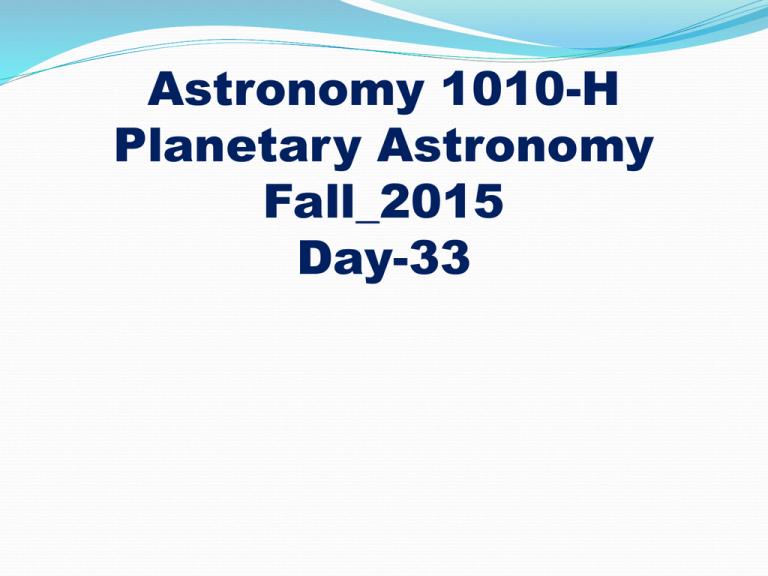Astronomy 1010-H Planetary Astronomy Fall_2015 Day-33
advertisement

Astronomy 1010-H Planetary Astronomy Fall_2015 Day-33 Course Announcements • How is the sunset/sunrise observing going? • • SW-chapter 9 due: Wed. Nov. 18 SW-chapter 10 due: Mon. Nov. 23 • I will collect the L-T books on Monday, Nov. 23 • 1st Quarter Obs. (last one of semester): Thurs. Nov. 19 Reports Due: Monday Nov. 23 – AT CLASS TIME! • You-tube CONNECTIONS 9.2 Convection along with Earth’s water cycle creates violent weather patterns on Earth, including thunderstorms, tornadoes, and hurricanes. Dust devils can also be created on Mars. Lightning on Venus and the giant planets. Parts of Earth are heated differently. Convection distributes surface heating. Hadley circulation transports heat between equator and poles. Global winds carry heat from hot to cool regions. On Earth, Venus, and Mars, the circulation depends on heating pattern and rotation period. The Coriolis effect breaks the larger convection cells into smaller ones. Climate is the average state of an atmosphere. Can be affected by astronomical, geological, and biological mechanisms. Astronomical: changes in the Sun’s energy output, change in a planet’s obliquity, and more. Geological: volcanic and tectonic activity. Biological: photosynthesis by bacteria and plants, methane byproducts, human activity. Paleoclimatology has yielded much information about Earth’s climate change. Has found temperature and climate cycles, including ice ages. Earth’s climate is very sensitive to changes in temperature. CONNECTIONS 9.1 The temperature of a gas is a measure of the average kinetic energy of its molecules. The motion of the gas molecules in an atmosphere creates its pressure. MATH TOOLS 9.1 If the speed of a gas molecule is less than a planet’s escape speed, it will be more easily retained. The speed is represented by the temperature. If the gas speed is less than 1/6 of the escape speed, the planet will keep its atmosphere. PROCESS OF SCIENCE When presented with complex science (such as climate change), it is important to analyze the issue inclusively from different angles. Jupiter, Saturn, Uranus, and Neptune are the giant planets. Jupiter and Saturn: mainly hydrogen and helium. 5.2 AU from Sun, and 9.6 AU from Sun. Called gas giants. Uranus and Neptune: smaller, have much more water, water ice, and other ices. 19.2 AU from Sun, and 30.0 AU from Sun. Called ice giants.


